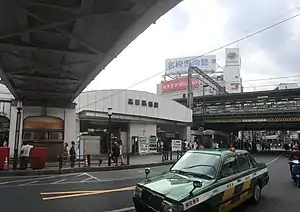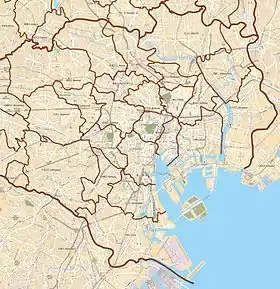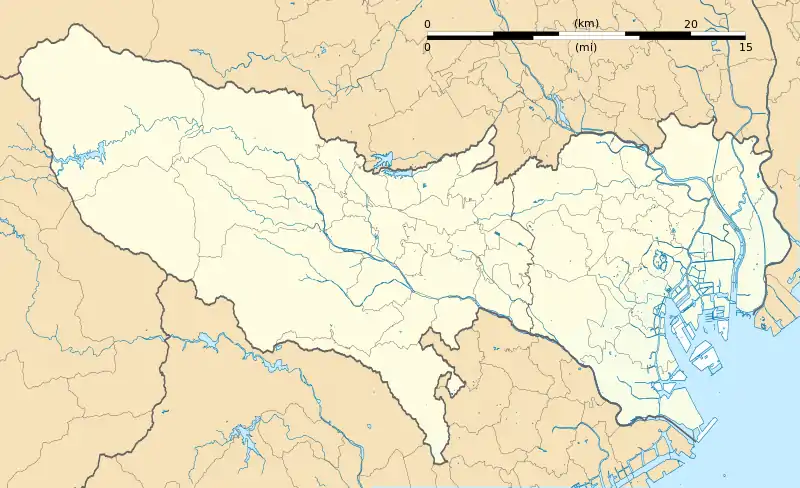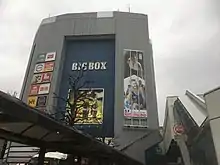Takadanobaba Station
Takadanobaba Station (高田馬場駅, Takadanobaba-eki) is a railway station in the Takadanobaba area of Tokyo's Shinjuku ward, situated between the commercial districts of Ikebukuro and Shinjuku.
JY15 SS02 T03 Takadanobaba Station 高田馬場駅 | |
|---|---|
 Waseda entrance, October 2020 | |
| Location | Shinjuku, Tokyo Japan |
| Operated by | |
| Line(s) |
|
| History | |
| Opened | 1910 |
| Location | |
 Takadanobaba Station Location within Special wards of Tokyo  Takadanobaba Station Takadanobaba Station (Tokyo)  Takadanobaba Station Takadanobaba Station (Japan) | |
The station is a major commuting hub, linking the Seibu Shinjuku Line, Tokyo Metro Tōzai Line and Yamanote Line. It also serves the surrounding Takadanobaba area, known as a popular student district, and is linked by bus to nearby Waseda University. It is the busiest station on the Seibu Shinjuku Line, and the second-busiest in the Seibu Railway network after Ikebukuro Station. It is the ninth-busiest station in the Tokyo Metro network and the eleventh-busiest station in the JR East network.
Lines
Takadanobaba Station is served by the following lines:
- East Japan Railway Company (JR East)
- Seibu Railway
- Tokyo Metro
- Tokyo Metro Tōzai Line
Station layout
Yamanote and Seibu Shinjuku Line
The Yamanote Line island platform and two Seibu Shinjuku Line platforms are located parallel to each other, and are connected by an overhead transfer concourse, as well as transfer gates at ground level by the main Waseda exit.
| 1 | JY Yamanote Line (Clockwise) | for Ikebukuro, Ueno, and Tokyo |
| 2 | JY Yamanote Line (Anti-clockwise) | for Shinjuku, Shibuya, and Shinagawa |
| 3 | for Tanashi, Tokorozawa, Haijima, and Hon-Kawagoe | |
| 4 | Spare arrival platform used for Seibu-Shinjuku bound trains on weekday mornings only | |
| 5 | for Seibu-Shinjuku |
The theme music from Astro Boy is played prior to each train departure from the Yamanote Line platform, a homage to the series being set in the Takadanobaba area. Chest-high platform edge doors were brought into use on the Yamanote Line platform on 21 December 2013.[1]
The Yamanote Freight Line tracks (used by Saikyo Line and Shonan-Shinjuku Line services) pass Takadanobaba running between the Yamanote Line and Seibu Shinjuku Line tracks.
 Yamanote line platforms, 2016
Yamanote line platforms, 2016 Seibu platform 5 with platform 3/4 on the left in March 2016
Seibu platform 5 with platform 3/4 on the left in March 2016
Tozai Line
| 1 | T Tokyo Metro Tozai Line | for Ōtemachi, Tōyōchō, Nishi-Funabashi JB Chuo-Sobu Line for Tsudanuma TR Toyo Rapid Railway Line for Tōyō-Katsutadai |
| 2 | T Tokyo Metro Tozai Line | for Nakano JB Chuo-Sobu Line for Mitaka |
 The Tozai Line subway platforms in October 2020
The Tozai Line subway platforms in October 2020
Adjacent stations
| « | Service | » | ||
|---|---|---|---|---|
| Yamanote Line JY15 | ||||
| Shin-Ōkubo JY16 | - | Mejiro JY14 | ||
| Tokyo Metro Tozai Line T03 | ||||
| Ochiai T02 | Rapid | Waseda T04 | ||
| Ochiai T02 | Commuter Rapid | Waseda T04 | ||
| Ochiai T02 | Local | Waseda T04 | ||
| Seibu Shinjuku Line SS02 | ||||
| Seibu Shinjuku SS01 | Koedo limited express[2] | Higashi-Murayama SS21 | ||
| Seibu Shinjuku SS01 | Haijima Liner (only for boarding) | Kodaira SS19 | ||
| Seibu Shinjuku SS01 | Rapid Express | TanashiSS17 | ||
| Seibu Shinjuku SS01 | Commuter express | Saginomiya SS09 | ||
| Seibu Shinjuku SS01 | Express | Saginomiya SS09 | ||
| Seibu Shinjuku SS01 | Semi express | Saginomiya SS09 | ||
| Seibu Shinjuku SS01 | Local | Shimo-Ochiai SS03 | ||
History
The Yamanote Line station opened on 15 September 1910.[3]
Seibu Railway opened a temporary station perpendicular to the Yamanote Line in April 1927, followed by a permanent station parallel to the Yamanote Line in April 1928. The original station buildings were burned to the ground during the bombing of Tokyo in April 1945. Takadanobaba was the Tokyo terminal of the Seibu Railway Murayama Line (now Seibu Shinjuku Line) until it was extended to Seibu-Shinjuku Station in 1952.
The Tozai Line began service to Takadanobaba in December 1964 under the auspices of the Teito Rapid Transit Authority. Takadanobaba was the western terminus of the Tozai Line until the connection to Nakano Station and the Chuo Main Line opened in March 1966.
Station numbering was introduced on all Seibu Railway lines during fiscal 2012, with Takadanobaba Station becoming "SS02".[4]

Surrounding area
The surrounding area of Takadanobaba is often referred to as "Baba". It lacks the history of nearby Waseda and Mejiro, often conjuring up images of a student spot with its many cheap bars and izakaya serving the needs of students at nearby Waseda and Gakushuin universities. Numerous prep and vocational schools reinforce this image in the eyes of many Japanese.
The symbol of Takadanobaba is the monolithic and appropriately named Big Box building next to the station. Big Box houses a sports gym, swimming pool, Uniqlo clothing store, cafe, bowling alley, arcade, and a fast food restaurant. It has recently been reopened after an extensive renovation.
Passenger statistics
Daily average passenger figures for each operator are as shown below.
| Fiscal year | Seibu | JR East | Tokyo Metro |
|---|---|---|---|
| 2000 | 211,761[5] | ||
| 2005 | 274,488[6] | 201,936[7] | |
| 2009 | 299,736[8] | 204,527[9] | |
| 2010 | 295,689[8] | 202,396[10] | |
| 2011 | 287,513[11] | 199,741[12] | |
| 2012 | 292,612[13] | 201,765[14] | 186,629[15] |
| 2013 | 292,694[16] | 201,513[17] | 189,308[18] |
- Note that JR East figures account for boarding passengers only.[14]
See also
- List of railway stations in Japan
- Transportation in Greater Tokyo
References
- 山手線高田馬場駅で可動式ホーム柵の使用開始 [Platform edge doors brought into use at Yamanote Line Takadanobaba Station]. Japan Railfan Magazine Online (in Japanese). Japan: Koyusha Co., Ltd. 22 December 2013. Retrieved 22 December 2013.
- "停車駅のご案内". Seibu Railway. Archived from the original on August 8, 2013. Retrieved August 5, 2013.
- Kawashima, Ryozo (March 2011). 日本の鉄道 中部ライン 全線・全駅・全配線 第12巻 東京都心北部 [Railways of Japan - Chubu Line - Lines/Stations/Track plans - Vol 12 Northern Central Tokyo]. Japan: Kodansha. p. 54. ISBN 978-4-06-270072-6.
- 西武線全駅で駅ナンバリングを導入します [Station numbering to be introduced at all Seibu stations] (PDF). News Release (in Japanese). Japan: Seibu Railway. 23 February 2012. Archived from the original (PDF) on 2015-09-24. Retrieved 2 April 2013.
- 各駅の乗車人員 (2000年度) [Station passenger figures (Fiscal 2000)] (in Japanese). Japan: East Japan Railway Company. Retrieved 1 August 2013.
- 駅別乗降人員 2005(平成17)年度 1日平均 [Average daily station usage figures (fiscal 2005)] (PDF) (in Japanese). Japan: Seibu Railway. Archived from the original (PDF) on 2016-03-05. Retrieved 31 August 2014.
- 各駅の乗車人員 (2005年度) [Station passenger figures (Fiscal 2005)] (in Japanese). Japan: East Japan Railway Company. Retrieved 1 August 2013.
- 駅別乗降人員 2010(平成22)年度 1日平均 [Passenger usage statistics by station (Fiscal 2010)] (PDF) (in Japanese). Japan: Seibu Railway. June 2011. Archived from the original (PDF) on 2011-06-26. Retrieved 6 January 2013.
- 各駅の乗車人員 (2009年度) [Station passenger figures (Fiscal 2009)] (in Japanese). Japan: East Japan Railway Company. Retrieved 1 August 2013.
- 各駅の乗車人員 (2010年度) [Station passenger figures (Fiscal 2010)] (in Japanese). Japan: East Japan Railway Company. Retrieved 1 August 2013.
- 駅別乗降人員 2011(平成23)年度 1日平均 [Passenger usage statistics by station (Fiscal 2011)] (PDF) (in Japanese). Japan: Seibu Railway. May 2012. Archived from the original (PDF) on 2012-11-01. Retrieved 6 January 2013.
- 各駅の乗車人員 (2011年度) [Station passenger figures (Fiscal 2011)] (in Japanese). Japan: East Japan Railway Company. Retrieved 1 August 2013.
- 駅別乗降人員 2012(平成24)年度 1日平均 [Average daily station usage figures (fiscal 2012)] (PDF) (in Japanese). Japan: Seibu Railway. Archived from the original (PDF) on 10 September 2013. Retrieved 5 August 2013.
- 各駅の乗車人員 (2012年度) [Station passenger figures (Fiscal 2012)] (in Japanese). Japan: East Japan Railway Company. Retrieved 1 August 2013.
- "各駅の乗降人員ランキング|東京メトロ".
- 駅別乗降人員 2013(平成25)年度 1日平均 [Average daily station usage figures (fiscal 2013)] (PDF) (in Japanese). Japan: Seibu Railway. Archived from the original (PDF) on 14 July 2014. Retrieved 22 June 2014.
- 各駅の乗車人員 (2013年度) [Station passenger figures (Fiscal 2013)] (in Japanese). Japan: East Japan Railway Company. Retrieved 31 August 2014.
- 各駅の乗降人員ランキング [Station usage ranking] (in Japanese). Tokyo Metro. Retrieved 31 August 2014.
External links
| Wikimedia Commons has media related to Takadanobaba Station. |
- JR East station information (in English)
- Seibu station information (in Japanese)
- Tokyo Metro station information (in English)